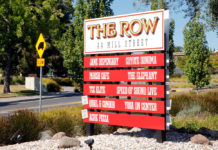
The welcome mat for Sonoma County’s wine country was rolled up several weeks ago in the midst of the COVID-19 shelter-in-place, and there is no prediction of when it might be rolled out again. Only a little over one quarter (27.8%) of the county’s 7,000 lodging rooms were occupied at the beginning of this month, down from an average occupancy rate of 78% from a year ago.
The economic ripple effects on the rest of the local economy are just beginning to be calculated as the county’s $2.175 billion annual tourism economy is now all but closed. Among the 24,750 workers recently filing for unemployment here, it is estimated that 12% are from the hospitality and restaurant industry.
Elsewhere, air passengers arriving at the county’s Charles M. Schulz Airport numbered only half of normal traffic in March, after several daily flights were canceled in mid-month. Final passenger numbers for April are expected to be as much as halved again, according to one recent industry prediction. Last year, almost 500,000 air passengers were served at the regional airport.
“Our hospitality businesses were the first to get hit and will likely be the last to come out (of a reopened economy),” economist Dr. Robert Eyler, of Sonoma State University, told the county’s Board of Supervisors on Tuesday. “When this local unemployment picture finally spikes, it will truly be historic.”
Parts of Sonoma County that beckon the most visitors in good times will face the hardest economic hits. These include Healdsburg, the lower Russian River and the Sonoma Coast, according to Eyler’s report. Where almost 11 million visitors came to Sonoma County in 2018, the leaders of Sonoma County Tourism (SCT), an industry marketing agency funded partially from room occupancy taxes, is bracing for a 33% reduction ($1.8 million) in operations for 2020-2021. A consultant for the local tourism group predicts the economic hit will be “seven times more economically devastating than the terror attacks of 9-11.”
Needless to say, the tourism promotion group has already downsized its staff and operations and has canceled almost all advertising and marketing programs for the time being. When any lights are turned back on, the SCT’s “Life Opens Up” media campaign will be shifted much closer to home in the Bay Area and other “drive markets.”
But as Dr. Eyler and others said, no one can predict when visitors will feel safe to travel again, even if the county’s welcome mat is rolled out again.
“Restaurants might do safe social spacing and outdoor events might take place under new guidelines, but will the people come?” he asked.
“We have many people on the river who have barely recovered from last year’s flood,” said west county Supervisor Lynda Hopkins. “What are their lifelines?”
Guerneville and nearby river resorts and campgrounds are part of a very seasonal local economy, dependent on summer beachgoers, vacationing families and special attractions including a rodeo, gay pride parade and wine-related events.
“This is all heart-rending,” Sheba Person-Whitley, executive director of the county’s Economic Development Board told the supervisors during their weekly meeting, now being held via Zoom. Commenting on the many thousands of newly unemployed workers, she said, “these were people who were living week-to-week and now it is day-to-day.”
Supervisor David Rabbitt, while listening to the various economic reports said, “we don’t see our tourism bouncing back anytime soon.” Rabbitt and fellow supervisors expressed frustration over the negative impact the forced closing of non-essential businesses was causing. The county’s public health officer, Dr. Sundari Mase, ordered county residents to shelter-in-place March 17 when only essential businesses including grocery stores, pharmacies and gas stations could remain open.
Dr. Eyler did not offer a positive outlook as he outlined a “tricky scenario” of a phased re-opening of portions of the local economy and an “ugly scenario” where a too-soon re-opening would lead to a second outbreak of coronavirus cases.
“My ugly scenario says our local economy might not rebound until 2023,” he said.
Even his less dire economic forecast showed a total wipeout of the last five years of local job growth.
The SCT forecast predicted a 90% loss of overall tourism-related revenues this month (April.) Embedded in this number is a big hit to the county government’s anticipated collection of transient occupancy taxes which totaled $194.8 million last year. The SCT organization reported it has only 90 days of reserve funds, following recent years of similar hits from the 2017 and 2019 wildfires which also kept tourists away from the Sonoma wine country.








